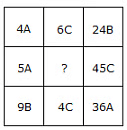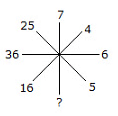Overview: Puzzles | CSAT Preparation - UPSC PDF Download
CSAT Angle
From the analysis of Previous Years Papers, it has come to the notice that this chapter has got great importance, each year lot of questions are asked from this chapter alone.
In the year 2024, two questions and in other Previous Years approximately 4-5 questions were asked directly from this chapter every year.
From the exam point of view, it is very important to cover this chapter with through understanding.
Puzzles
- A puzzle is a problem or enigma that tests the ingenuity of the solver. In a basic puzzle, one is intended to put pieces together in a logical way in order to arrive at the correct solution of the puzzle.
- In a puzzle, the candidates are provided with the information in jumbled or haphazard format. It checks the candidates' ability (both mental and analytical) to decipher, sequence and analyse the given information into a meaningful and judgemental form so as to come to the final decision or conclusion by following the systematic pattern of linking and interlinking one or several information with each other.
- This type of puzzles contains a paragraph of information which are in jumbled format and candidates are required to unjumble those statements and decipher the proper meaning from the paragraph to determine the answer. In these types of questions, conditions regarding the selection or non-selection of persons is given with respect to one another. On the basis of this information, team selection can be made to answer the questions.
- Puzzles can be based on different situations and fields, for example, a puzzle can be in the form of some persons liking different games or in the form of sitting or standing arrangement of some persons etc.
- You will get more clear to it by the following illustrations.
Illustration: The music director of a film wants to select four persons to work on ‘different aspects of the composition of a piece of music. Seven persons are available for this work, they are Rohit, Tanya, Shobha, Kaushal, Kunal, Mukesh and Jaswant. Rohit and Tanya will not work together. Kunal and Shobha will not work together. Mukesh and Kunal want to work together.
Which of the following is the most acceptable group of people that can be selected by the music director? UPSC (CSAT)
(a) Rohit, Shobha, Kunal and Kaushal
(b) Tanya, Kaushal, Shobha and Rohit
(c) Tanya, Mukesh, Kunal and Jaswant
(d) Shobha, Tanya, Rohit and Mukesh
Sol: (c) Rohit and Tanya cannot work together means that options (b) and (d) are out. Kunal and Shobha will not work together and so option (a) is out. Hence, the right answer is (c), where no one has problem working with another person of the group and Mukesh and Kunal can also work together.
Some examples are given below:
Example 1: Which number will replace the question mark ? Solution:
Solution:
From fig. a: 6 + 4 + 8 = 18
18 + 2 = 20
From fig. b: 7 + 9 + 8 = 24
24 + 2 = 26
From fig. c: 6 + 5 + 12 = 23
23 + 2 = 25
Hence the number 25 will replace the question mark.
Example 2: Which number will replace the question mark ? Solution:
Solution:
From fig. a: (3)2 + (2)2 = 13
From fig. b: (4)2 + (8)2 = 80
From fig. c: ? = (1)2 + (5)2
? = 1 + 25
? = 26
Hence the number 26 will replace the question mark.
Example 3: Which number will replace the question mark? Solution:
Solution:
From fig. a: 7 x 6 + 3 = 45
From fig. b: 5 x 4 + 6 = 26
From fig. c: 7 x 3 + 8 = 29
Hence the number 29 will replace the question mark.
Example 4: Which number will replace the question mark ? Solution:
Solution:
From column I: (9 x 5) % 5 = 9
From column II: (17 x 4) % 4 = 17
From column III: (16 x ?) % 8 = 8
16? = 64
? = 4
Hence the number 4 will replace the question mark.
Example 5: Which number will replace the question mark ? Solution:
Solution:
From fig. a: (8 x 5) - (4 x 3) = 28
From fig. b: (12 x 7) - (8 x 9) = 12
From fig. c: (5 x 3) - (6 x ?) = 21
15 - 6? = 21
6? = -6
? = -1
Hence the number -1 will replace the question mark.
Example 6: Which number will replace the question mark ? Solution:
Solution:
In each row there are 'A', 'B' and 'C'
In second row 'A' and 'C' are already there
Hence in place of ?, there will be 'B'.
From first row : 4A x 6C = 24B
From third row : 9B x 4C = 36A
From second row : 5A x ? = 45C
? = (45C/5A)
? = 9B
Hence the number 9B will replace the question mark.
Example 7: Which number will replace the question mark? Solution:
Solution:
(5)2 = 25
(6)2 = 36
(4)2 = 16
(7)2 = 49
Hence the number 49 will replace the question mark.
Example 8: Which one will replace the question mark?

Solution:
(15 x 2 - 3) = 27
(31 x 2 - 6) = 56
(45 x 2 - 9) = 81
|
205 videos|264 docs|136 tests
|
FAQs on Overview: Puzzles - CSAT Preparation - UPSC
| 1. What are some common types of puzzles encountered in CSAT exams? |  |
| 2. How can I improve my puzzle-solving skills for the CSAT exam? |  |
| 3. Are there any specific strategies for tackling seating arrangement puzzles? |  |
| 4. How much time should I allocate for solving puzzles during the CSAT exam? |  |
| 5. Where can I find practice materials for CSAT puzzles? |  |





















